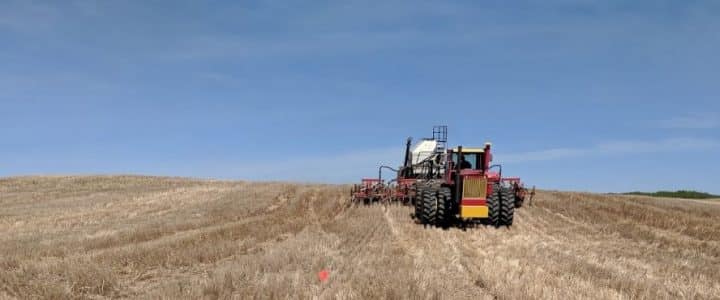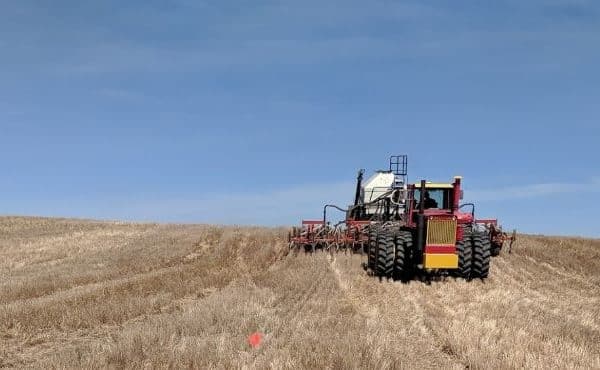The fertilizer application goal of maximizing nutrient use efficiency by ensuring nutrients are available to the plants without causing toxicity and by minimizing losses to the environment can be challenging. But choosing application practices that use the Right placement, Right source, Right rate and Right timing (as part of the 4R Nutrient Stewardship recommendations) for each crop and for field conditions will help achieve this, while promoting both environmental sustainability and profitability for growers. It will also contribute to the Canola Council of Canada’s (CCC) goal of 90 per cent of canola acres using 4R practices by 2025.
Equipment upgrades, new technologies and the generation of more information through decades of research have aided in the improvements and evolution of application practices over the years, despite the complexity of nutrient management. Considering current nitrogen and phosphorus-containing fertilizer application options, this blog reviews relevant research related to the right placement of fertilizer for canola production systems across western Canadian conditions.
Nitrogen fertilizer placement
The Impact of source and placement of nitrogen and sulphur fertilizers on canola study led by Ramona Mohr was conducted in field trials in 2017 on calcareous and non-calcareous soils in Manitoba. The research compared placement methods (pre-plant broadcast, pre-plant band or dribble band after seeding) of various fertilizer sources: Results included:
- Banding often reduced early-season volatile nitrogen losses compared to surface-applied fertilizer nitrogen applications, particularly at the calcareous site. Banding also showed increased nitrogen uptake at flowering, suggesting in-soil banding contributed to a higher available nitrogen supply.
- Though the differences among the fertilizer management practices were less frequent at the non-calcareous site, pre-plant banding at the calcareous site consistently increased canola yield compared to surface application of granular fertilizer nitrogen products, while pre-plant banded urea increased yield compared to surface application of both conventional and enhanced efficiency fertilizers.
- The nitrogen fertilizer recovery percentage was typically higher for banded than broadcast granular fertilizers at the calcareous site.
- Although in some cases in the current study, surface-applied conventional or enhanced efficiency fertilizers performed as well as banded treatments, in no case did surface-applied fertilizer nitrogen outperform banded urea in terms of nitrogen use efficiency or crop performance.
- Therefore, it was concluded that:
- Decisions regarding surface-application versus in-soil banding of fertilizer nitrogen require consideration not only of operational requirements and the direct costs of fertilizer applications, but also of the relative risk of nitrogen loss of surface-applied nitrogen and the implications with respect to return per fertilizer dollar.
- Findings reflect previous research in western Canada which supports the use of in-soil banding of nitrogen fertilizers during seeding or near to the time of seeding as a best management practice to enhance nitrogen use efficiency in canola and other crop production systems.
Learn about the impact of different fertilizer placements in this study on the project page.
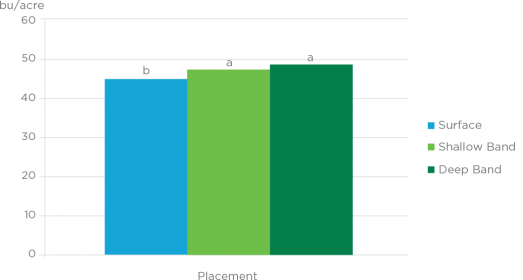
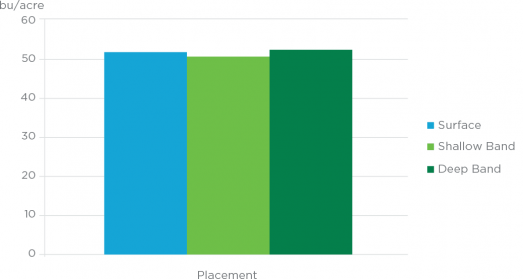
Mario Tenuta’s Canola response and minimizing nitrogen losses in two-pass seeding-fertilization systems with varying placement methods in Manitoba study comparing surface, shallow band and deep band nitrogen applications reported the following:
- Deep banding reduced nitrogen losses compared to shallow banding and surface application. These losses, though, tended to be higher in lightest soil used in the study (which ranged from Carman clay loam to heavy Red River Valley clay to at the six sites in east-central Manitoba).
- There was no statistical yield difference between banding depths, though deep banding had 1 bu./ac. more yield than shallow banding.
- Yield was much higher for spring surface applications compared to the fall surface applications.
- Therefore, it was concluded that:
- Deep banding in the spring or late fall is still the best method to increase nitrogen use efficiency, reduce losses (and greenhouse gas emissions) and, for rates below the soil test recommendations, to increase yields.
- Growers who need to utilize broadcast applications for logistical purposes, should aim to do in the spring to reduce losses (and consider using a urease-inhibitor product with the spring broadcast applications).
It was also noted that additional trials testing these treatments are recommended across other soil types and growing regions of the Prairies to provide valuable yield insight for canola farmers, especially for those using rates below soil-test recommendations.
Tenuta’s research abstract provided this helpful explanation about fertilizer losses, which is supported by the CCC nitrogen cycle graphic below:
Surface fertilizer applications increase the risk of nitrogen loss through NH3 volatilization, which occurs when urea hydrolysis elevates soil pH levels and increases the concentration of gaseous NH3 around the fertilizer granules. Alternatively, when fertilizer granules are deep banded (>3 inches) or buried in the soil, gaseous NH3 formed around urea granules can be interconverted to ammonium (NH4+), a non-volatile ion which subsequently absorbs to negatively charged soil particles. However, deep banding does require additional horsepower and can slow field operations at seeding time and may have undesirable effects on seedbed quality and moisture content.
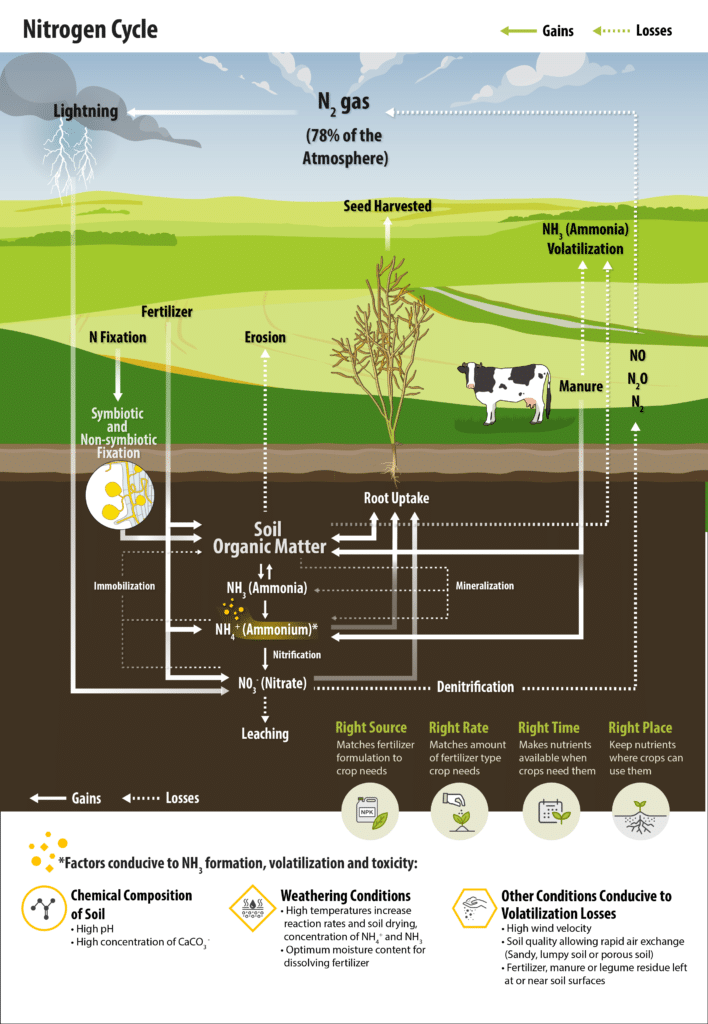
The Evaluation of sap nitrate for in-season assessment of crop nitrogen status research by Dale Tomasiewicz comparing nitrogen applications methods and placements reported:
- No canola yield advantage of the split application of side-banding at seeding plus in-season through an irrigation system (fertigation) compared to the side-banding at seeding treatment.
- However, fertigation allows the flexibility of adjusting rates based on conditions through the season for farmers that have the set-up.
- Emissions of the greenhouse gas nitrous oxide (N2O) were affected more by the total amount of fertilizer nitrogen applied than by the placement method.
- Although total seasonal emissions of N2O were generally low, well under one kilogram of N2O-N per hectare, in all monitored treatments in all years.
Phosphorus fertilizer placement
Jeff Schoenau’s Crop response to foliar-applied phosphorus fertilizers research determined that while canola yield results suggest some uptake of phosphorus through leaf material, foliar phosphorus application did not effectively balance off the yield lost when rates of seed-placed monoammonium phosphate (MAP) fertilizer were reduced. Foliar phosphorus applied mid-season appeared to be the most effective as a top-up rather than a replacement for seed-row applied phosphorus. Therefore:
- The foliar option for phosphorus fertilizer is not a good alternative to seed placed – unless the field is known to be highly deficient (less than 10 parts per million of phosphorus in the top six inches of soil) and no other applications were made to address this deficiency.
- The preferred approach is to apply phosphate fertilizer in the soil at a time when the crop can access it early in its growth cycle. This could be done with a combination of seed-row placement (at safe rates) and sideband or spring-band placement to achieve the recommended application rate as dictated by soil tests.
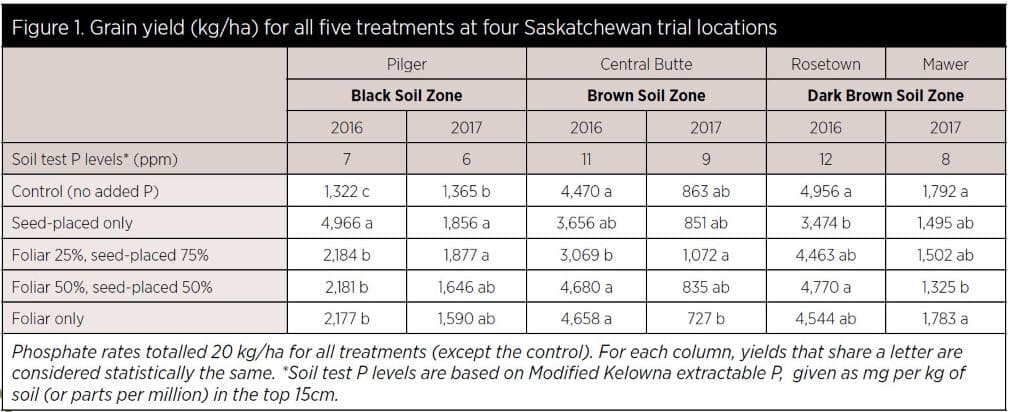
Jessica Pratchler and Stewart Brandt’s Enhancing canola production with improved phosphorus fertilizer management research concluded that seed-placed phosphate is not recommended and most of the phosphorus fertilizer applied should be side-banded, especially when higher rates are needed. This was based on the following results:
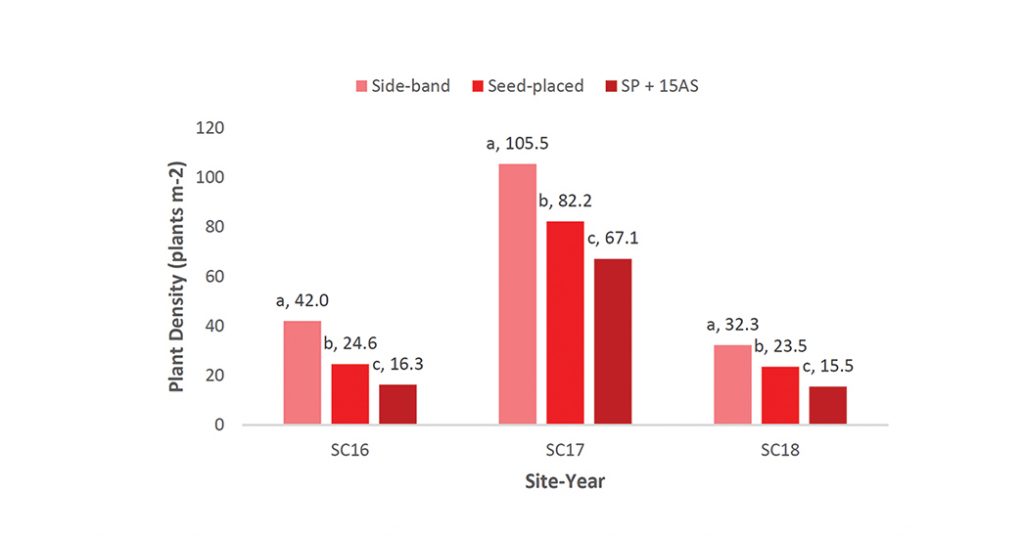
- Results showed damage to canola stand establishment even from very low rates of seed-placed phosphate, but damage was not as severe as with previous studies. Researchers wondered if those results were due to using a hoe-type opener, which has higher seed-bed utilization (and thus improved seed safety from fertilizer), instead of disc opener.
- However, predicting the degree of damage caused by seed-placed fertilizer is very difficult as it is influenced by other factors such as soil texture, soil organic matter and moisture. Since these factors vary considerably across most fields, damage can be quite variable across the various landscape positions.
- Furthermore, even adding a small amount of ammonium sulphate to phosphorus in the seed-row can increase damage to seeds and reduce canola emergence.
- Overall, no evidence was found of better responses associated with seed-placed phosphorus over side-band phosphorus, even at low rates, and that high rates of side-banded phosphorus are always equal to or greater than seed-placed. This was true for stand establishment and yield.
- Yield improved with higher phosphorus rates in general, and in some cases, were found to be even greater with side band treatments, especially at higher rates.
- Therefore, if high rates of phosphorus are required, fertilizer phosphorus should be side-banded to minimize seed damage and maximize yields as it was the most consistent and beneficial application method. Due to minimized seed damage, the high plant populations achieved as a result of side banding can provide the added benefit of reduced days to maturity, which will lower green seed risk.
In the Reducing toxicity of seed-placed phosphorus fertilizer in canola, Patrick Mooleki investigated the maximum safe rate of seed-placed phosphorus fertilizer with different opener widths and row spacing, and to develop guidelines for producers and crop advisors to use (after recognizing a frequently asked question was ‘how much P fertilizer can they apply with the seed if they are using a wider (2″, 3″ or 4″) opener?’. The following outcomes were reported:
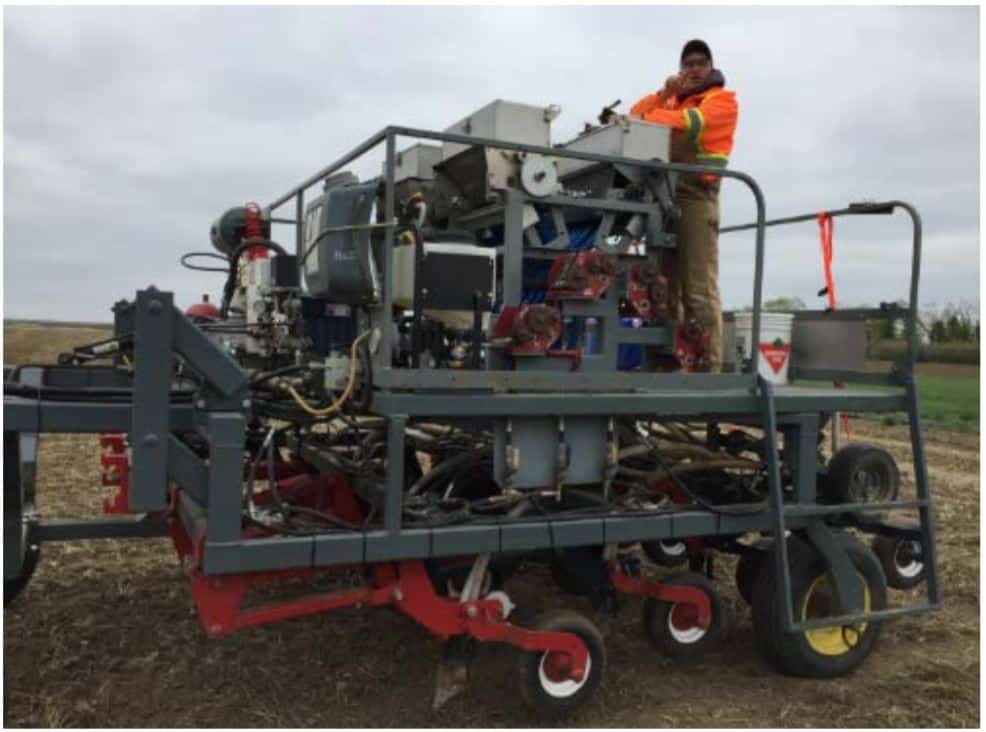
- Increasing seed bed utilization (SBU) by either narrowing row spacing from 12″ to 9″ and/or increasing opener width from 1″ to 4″ results in reduced phosphorus toxicity of seed-placed phosphorus fertilizer, leading to increased number of plants per unit area. However, changing the SBU did not consistently impact the plant recovery of phosphorus fertilizer applications, and SBU does not appear to be a major factor affecting utilization of fertilizer phosphorus by canola.
- It was concluded that increasing rate of seed-placed phosphorus fertilizer can cause significant reduction in plant density due to increased toxicity of the phosphorus fertilizer to canola seeds and seedlings.
- This can be mitigated by increasing the width of the openers, and/or using narrow row spacing (which increases SBU). However, the impact on yield and quality of the canola is small.
- Therefore, producers seeding at 12″ row spacing should avoid using openers less than 2″ wide if seed-placing phosphorus fertilizer. At 12″ row spacing, using 4″ wide openers could help reduce toxicity of seed -placed phosphorus fertilizer. If seeding at 9″ row spacing, opener width should not exceed 2″ as doing so could result in too much soil being thrown over rows seeded by front row openers.
- Producers who are placing nitrogen and sulphur fertilizers away from the seed have more room to increase seed-placed phosphorus fertilizer without causing significant reduction in plant density and grain yield of canola.
- Opener configuration does not greatly influence phosphorus fertilizer recovery from seed-row placed phosphorus fertilizer.
- It was concluded that increasing rate of seed-placed phosphorus fertilizer can cause significant reduction in plant density due to increased toxicity of the phosphorus fertilizer to canola seeds and seedlings.
The phosphorus trial in Ken Coles’ Developing canola agronomy with precision planters project reported:
- Liquid phosphorus applications at 60 kg/ha showed some degree of seedling mortality with precision planters (12″ and 20″), which led to lower plant emergence and canopy covering.
- No observation of seedling mortality or decrease in plant emergence was made for the lower phosphorus application rates between 0 to 40 kg/ha for any of the seeders.
- Crops were able to recover from the initial losses when narrow (12″) precision planters were used, leading to no substantial difference in yield for various phosphorus application rates.
- However, crop recovery was less effective for the 20″ planter, thus leading to a lower yield at 60 kg/ha application rate of liquid phosphorus.
It should also be pointed out, that the Evaluation of emission reductions and cost saving in sectional control air seeders, drills and sowing equipment across the Canadian Prairies (Phase 2) study highlights the impacts sectional control can have on various factors, such as reducing fertilizer application overlaps to avoid overapplied fertilizer which could potentially lead to undesirable effects on a crop.
Production recommendations and resources
To further improve the impacts of fertilizer placement in a field, growers should also consider their seed placement. In the November 2021 Canola Digest Canola Council of Canada nutrient management lead Warren Ward offers this advice, after a dry 2021 growing season, “get the drill ready to seed shallow and uniformly. Slow down if necessary to improve seed placement.”
4R Nutrient Stewardship recognizes that “the type of crop, fertilizer source, row spacing, and soil environment all affect how much fertilizer can be safely applied with seed.” But for a quick reference on recommended management practices regarding the right placement of fertilizer, see Table 1.
Table 1. 4R Practices for spring cereal, oilseed, and pulse rotations in the Canadian Prairies without manure or compost – Prairie and Boreal plains ecozones
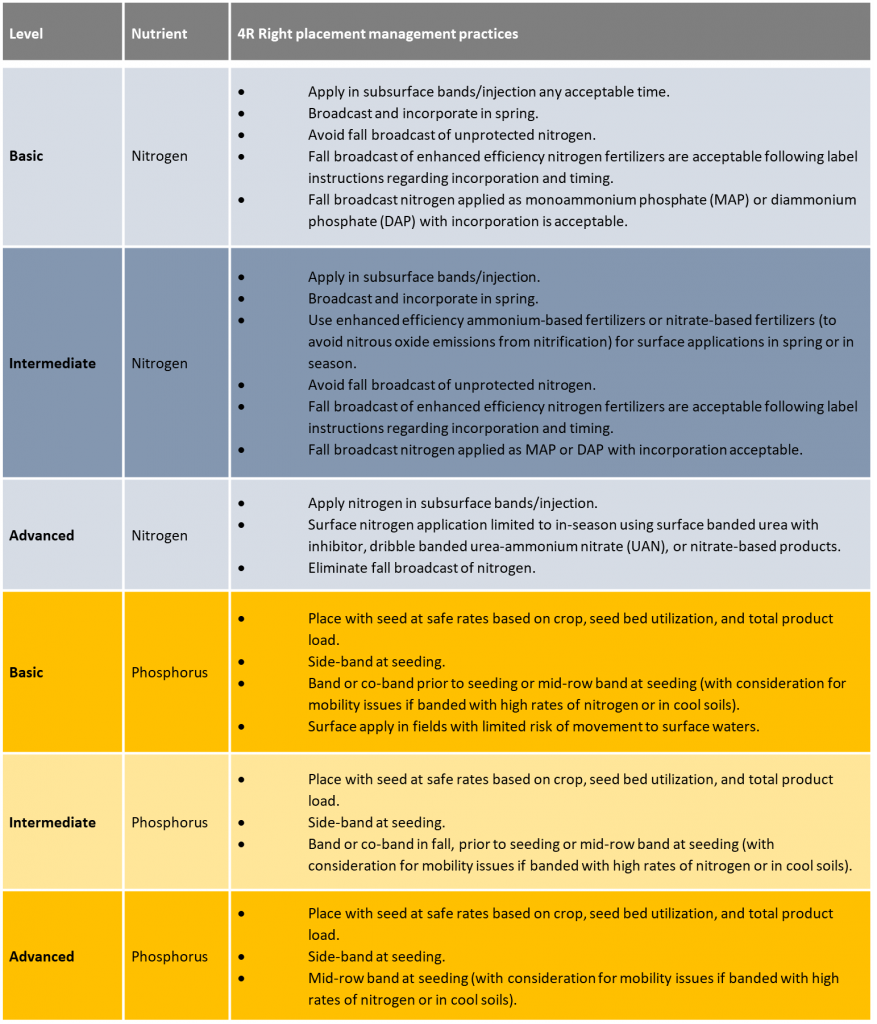
For 4R consistent nitrogen BMPs for eligible annual crops in the Alberta Nitrous Oxide Emission Reduction Protocol (NERP) see 4R Guidance Tables.
The initiative, led by Fertilizer Canada, also provides these related resource and research sources:
- Fertilizer Canada 4R resources for agronomists
- Fertilizer Canada 4R resources for farmers, including where to find a designated agronomist
- Placing Fertilizer with Seed
- Nutrient Stewardship Research updates
- IPNI Research Summaries 2017 Crop Year
Check out these short Canola Watch videos on fertilizer placement:
As well, these Canola Watch articles provide interesting 4R nutrient stewardship tips for growers and agronomists:
- Tips to apply nitrogen and sulphur in season
- Canola Discovery Forum 4R panel – more Q&A at canolawatch.org
- Highlights from Canola Week 2020” at canolawatch.org
Read about what nutrient management practices are working for farmers in these Canola Digest articles:
- Your 4R fertilizer management plan for 2021
- How to increase yield with fertilizer
- Goal: 90% of acres under 4R
- Use soil tests to take advantage of a challenging year
- Simple 4R tips to improve profitability
- What fertilizer practices are the worst for losses
Further research
To learn about the impacts of fertilizer rates had on canola, check out these other studies features on the Canola Research Hub:
- Main factors affecting nutrient and water use efficiencies in spring canola in North America: A review of literature and meta-analysis
- Ultimate Canola Challenge (On-farm research)
- Variable nitrogen fertility management of canola at the field scale, based on analysis of yield maps and spatial and statistical variability of soil test nitrogen and phosphorous
- Enhancing nitrogen management for canola production: addressing field, spatial and temporal variability with in-crop variable rate applications of nitrogen fertilizer
Published November 10, 2021


